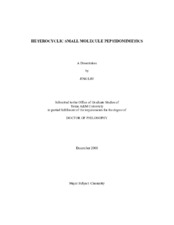| dc.description.abstract | Polymer-supported synthesis of a close analog (i.e. A) of an early lead, a 14-
membered ring peptidomimetic D3, was described. The monovalent molecule was
attached to different length linkers, and they were then paired sequentially on a triazine
scaffold via our previously published methodology to give a small library of bivalent
compounds 1 representing all combinations of linkers of the different lengths in a fast and
efficient combinatorial manner. Cellular assays identified 1-ss as a TrkA receptor
antagonist towards NGF and it was shown to bind TrkA with ~200 nM affinity and
retains high selectivity towards TrkA in binding assays.
A set of monovalent diketopiperazine (DKP) mimics 4-7 was synthesized
efficiently from corresponding dipeptides via intramolecular SN2 cyclization reactions in
solution. These DKP compounds contain two amino acid side-chain functionalities to
mimic the sequences that occur at “hot-spots” in loop regions. The monovalent mimics
were assembled into a library of biotin-labeled bivalent molecules 9 via the combinatorial
strategy described above with some modification. In primary screening, compound 9gg
showed preferential binding to TrkC receptors in FACScan assay and blocked the trophic
activity of NT-3 in TrkC cells at 10 uM in cell survival assay.
The preparation of monovalent 1,3,4-oxadizole-based mimics 12 was achieved
from corresponding amino acid building blocks on gram scale in a highly efficient
solution phase parallel synthesis manner in good yields. These heterocyclic compounds
feature various natural amino acid side-chain functionalities including those occuring
most frequently at hot-spots such as those of Tyr, Lys, Glu and Ser. Attempts to
assemble them into bivalent molecules were done by coupling the monovalent mimics to the triazine scaffold sequentially in solution and simply manipulating the solvent systems.
For some reasons, some reactions did not proceed cleanly. Studies have been carried out
and the problems were partially solved. The biological activities of these oxadiazoles are
under investigation. So far, six compounds have shown activities in four different
bioassays.
Two different peptidomimetic types that resemble protein A and protein G
binding regions were generated and tested as binding factors in affinity columns for
purification of IgG. They are cyclic hexapeptides 19, which were prepared via Fmoc-
SPPS and solution phase intramoleculer macrocyclization, and heterocycle-based small
molecules 22 and 23 featuring a variety of aromatic functionalities generated via solution
phase parallel synthesis. Four compounds showed some affinity towards a Fab fragment
of IgG in SAR screening, and they were attached to a dendrimer core on a solid support
to give four multivalent mimetics 25. | en |


